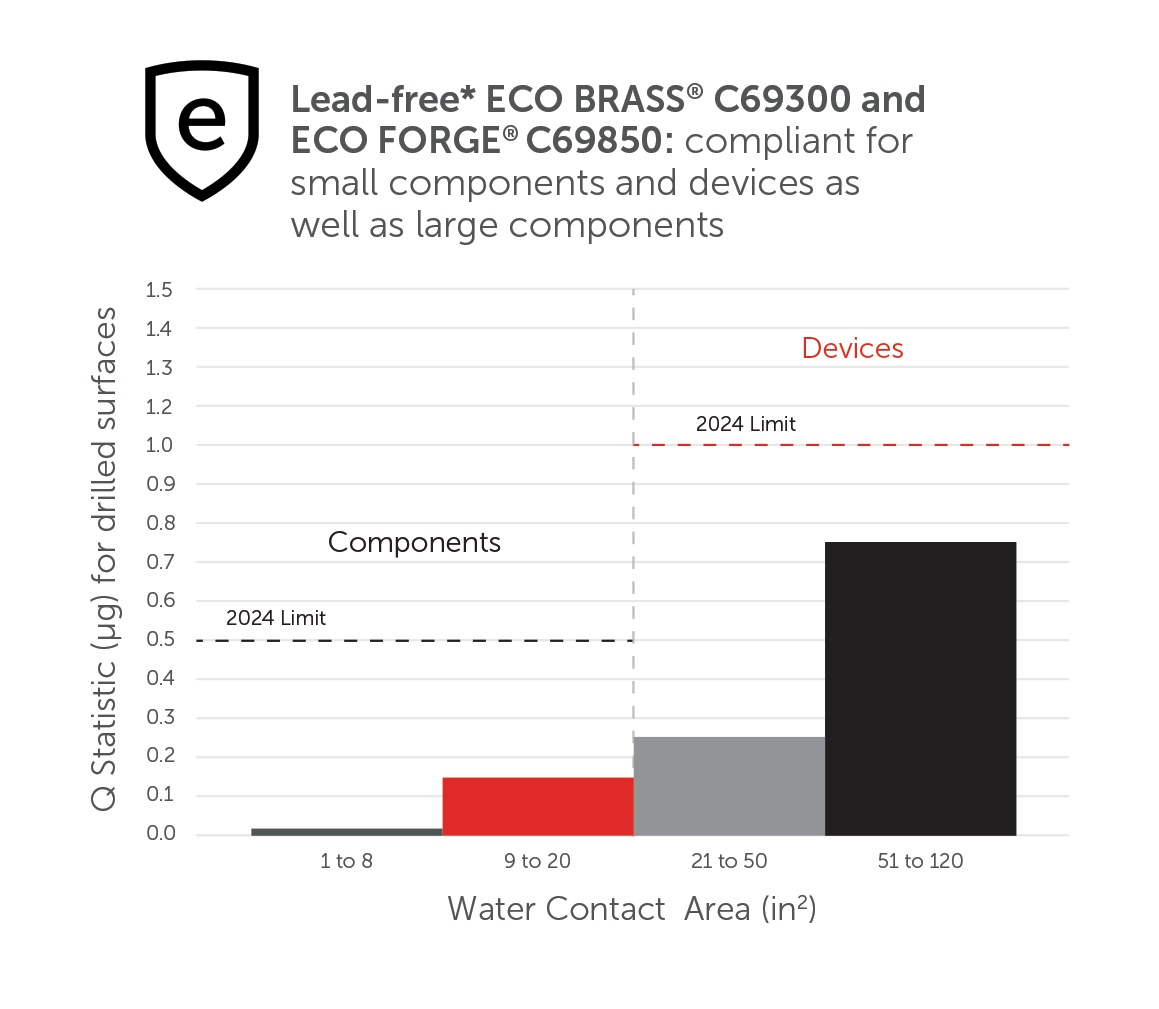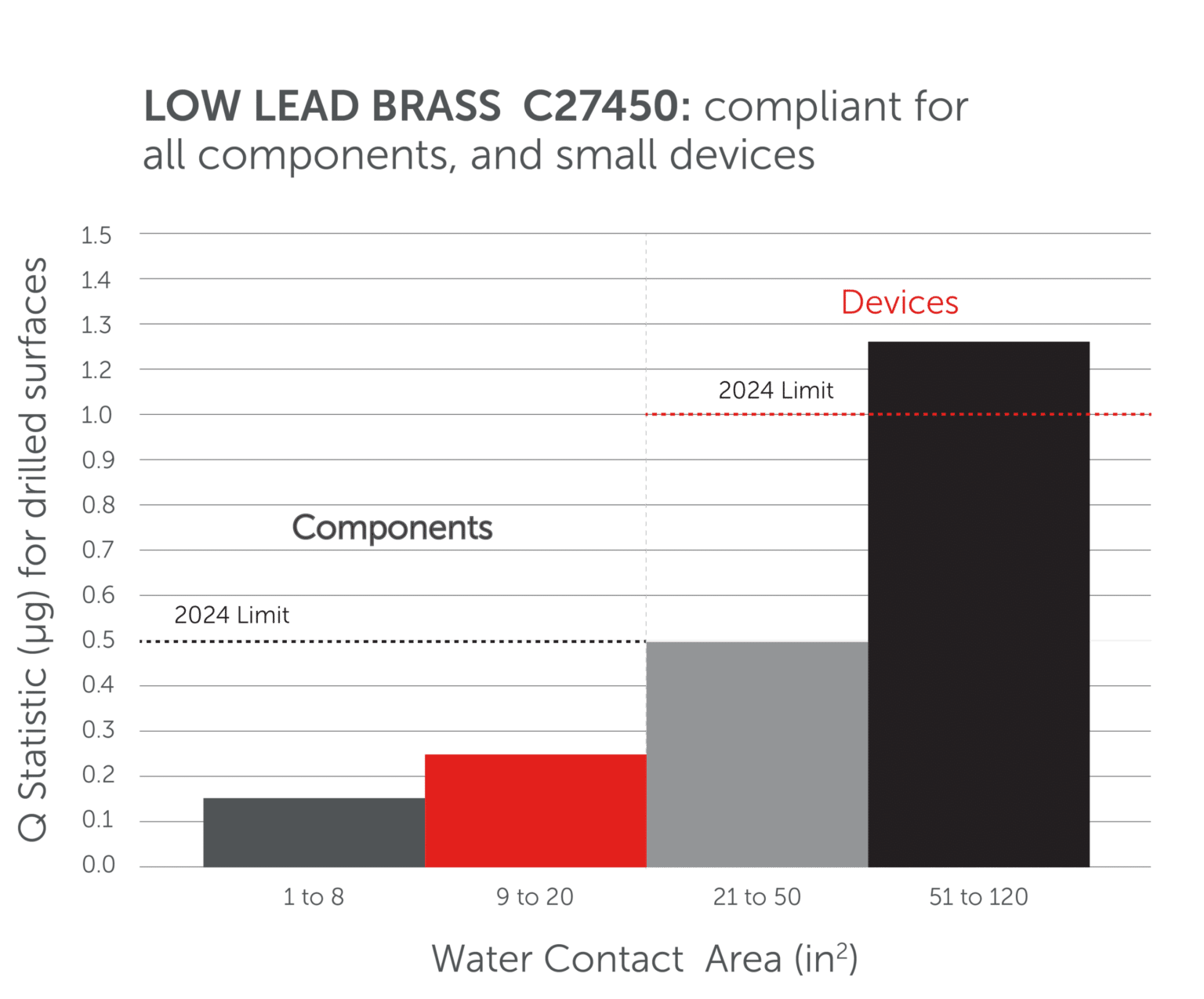NSF/ANSI/CAN 61 Compliance
Keeping You in Compliance
On January 1, 2024 the NSF/ANSI/CAN 61 Section 9 Lead Leachate Standard will become mandatory.
Be ready with our lead-free* and low-lead brass solutions
We have excellent American-made brass solutions that will ensure you comply with the current and coming standards. Our three brass options, ECO FORGE®, ECO BRASS®, and Low Lead Brass, have been successfully used for part production and are the ideal fit to keep your components compliant as we move toward 2024. These three options provide sound solutions to continue operating in compliance with NSF/ANSI/CAN 61, Section 9 lead leachate standard. Select the brass alloy that works best for the products you are manufacturing.
NSF/ANSI/CAN 61 Section 9 Requirements:
- Mandated as of January 1, 2024
- Reduced from 5 to 1 µg for endpoint devices (e.g. faucets)
- Reduced from 5 to 0.5 µg for components (e.g. valves)
AVERAGE “Q” VALUES FOR DRILLED, WATER CONTACT SURFACES, EXTRAPOLATED TO 8, 20, 50 AND 120 IN2


1 to 8 (in2)
Small Components
Fittings, shut-off valves, valve cartridges, center body tees, aerator housings
9 to 20 (in2)
Large Components
Faucet bodies & faucet spouts
21 to 50 (in2)
Small Devices
Bathroom faucets
51 to 120 (in2)
Large Devices
Kitchen faucets, drinking fountain bubblers
Our experts at Wieland Chase are here to discuss your specific manufacturing needs to ensure a smooth transition to a new alloy if needed. The mechanical properties and chemical composition of these alloys will meet your product’s requirements.
Alloy Properties and Machinability
| Tensile Strength (ksi) | Yield Strength (ksi) | Elongation (%) | Mid-Radius Hardness (Rb) | Dezincification Depth (µm)3 | Machinability (vs C360)4 |
| 90 | 48 | 35 | 88 | 40 | 85 |
| Tensile Strength (ksi) | Yield Strength (ksi) | Elongation (%) | Mid-Radius Hardness (Rb) | Dezincification Depth (µm)3 | Machinability (vs C360)4 |
| 77 | 55 | 22 | 87 | 40 | 82 |
| Tensile Strength (ksi) | Yield Strength (ksi) | Elongation (%) | Mid-Radius Hardness (Rb) | Dezincification Depth (µm)3 | Machinability (vs C360)4 |
| 63 | 40 | 28 | 74 | 400 | 70 |
Nominal Alloy Composition (with ASTM Ranges)
| Copper (%) Nominal | Lead (%) Nominal | Silicon (%) Nominal | Phos. (%) Nominal | Zinc (Approx. %) Nominal |
| 75.3 | 0.05 | 2.9 | 0.1 | 21.5 |
| ASTM | ASTM | ASTM | ASTM | ASTM |
| 73-77 | 0.09 max | 2.7-3.4 | 0.04-0.15 | Remainder |
| Copper (%) Nominal | Lead (%) Nominal | Silicon (%) Nominal | Phos. (%) Nominal | Zinc (Approx. %) Nominal |
| 68.4 | 0.05 | 1.7 | 0.09 | 29.8 |
| ASTM | ASTM | ASTM | ASTM | ASTM |
| 67.5 | 0.09 max | 1.53-2.0 | 0.04-0.15 | Remainder |
| Copper (%) Nominal | Lead (%) Nominal | Silicon (%) Nominal | Phos. (%) Nominal | Zinc (Approx. %) Nominal |
| 61.6 | 0.18 | – | – | 38 |
| ASTM | ASTM | ASTM | ASTM | ASTM |
| 60-65 | 0.25 max | – | – | Remainder |